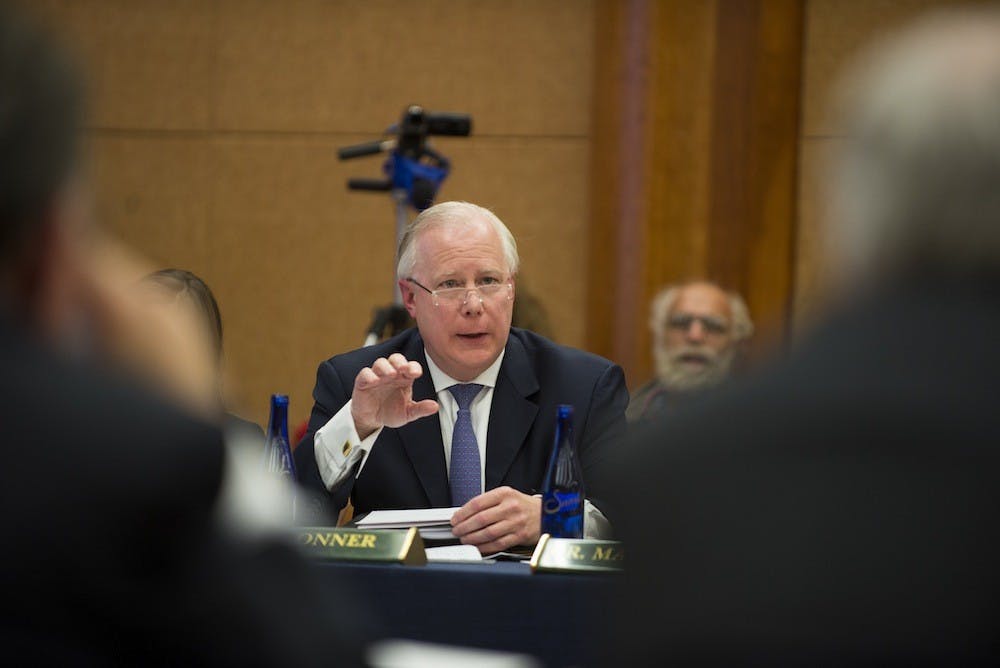The Board of Visitors Diversity and Inclusion Committee met Friday morning to discuss the University’s supplier diversity and the racial diversity within the University.
Director of Supplier Diversity Les Haughton presented the University’s Supplier Diversity report. He reviewed the University’s use of Small, Woman and Minority, or SWaM, firms.
“Our plan is to have a 45 percent total SWaM percentage,” Haughton said. “We fell short in 2014 — our SWaM percentage was 39.3. However, the women-owned percentage goal is 7 percent and it was 9 percent in 2014. For the past two or three years, [women-owned businesses] appear to be very strong and growing.”
Haughton said in the last five years, 2012 and 2014 showed a lower total of SWaM contractors compared to 2010, 2011 and 2013.
“Construction is a big driver of our SWaM percentages,” Haughton said. “In fiscal year 2012, there is a dip in our SWaM percentages and it is construction related. The major projects that started in fiscal 2010 and 2011 were completed. Our SWaM percentage in fiscal 2013 was 50 percent, which was the strongest SWaM percentage we have had in quite a while. In fiscal 2014, there was a big downturn due to few construction projects.”
The University is also involved in supplier diversity leadership through their membership in the Carolinas-Virginia Minority Supplier Development Council and in Virginia Association of State College and University Purchasing Professional SWaM Committee, Haughton said.
“In terms of outreach, the University of Virginia created SWaMfest, an annual event where we invite 60-70 small, medium and large firms to network and to share ideas,” Haughton said. “We host six vendor training sessions, where we invite 25 SWaM firms and we teach them how to go about doing business with the University. In 2014, we participated in 20 local and statewide events. Last year, we held the first MBE day on Grounds.”
Haughton introduced the University’s Black Faculty and Staff Resource Group, a group he has put together to benefit African American staff members, as well as the University as a whole.
“I’ve had a lot of success with these groups in my past; they are very, very powerful,” Haughton said. “Our goal is improvement, retention and community outreach. It is voluntary and grassroots and will provide networking opportunities, outreach and cultural awareness activities. It would also help to build reputation throughout the community. So far, there are about 40 active members.”
Marcus Martin, vice president and chief officer for diversity and equity, then showed the Committee the University’s Diversity Data Dashboard, a website of compiled, up-to-date data on racial diversity at the University.
“There is a subtle rise in the minority numbers total, even in faculty category, where there has been a decrease in faculty in the last five to six years,” Martin said. “White totals have been going down a little bit.”
He also cited a study done in 2011 by the Association of American Universities which compared the University’s racial percentages of tenure track faculty among 60 other peer institutions. The University ranked 18th for black faculty, 58th for Hispanic faculty, 56th for Asian-Pacific Islander faculty and 54th for female faculty.
“We do have our work cut out, but I am very optimistic that we can improve our diversity at the University of Virginia,” Martin said. “We have the opportunity to improve our numbers for women and minority faculty, particularly with the large faculty turnover expected due to retirements. We are working on a compressive strategy of diversity plan for the University this year, the Provost has already met with the deans, and we are focusing on recruiting diverse faculty.”







